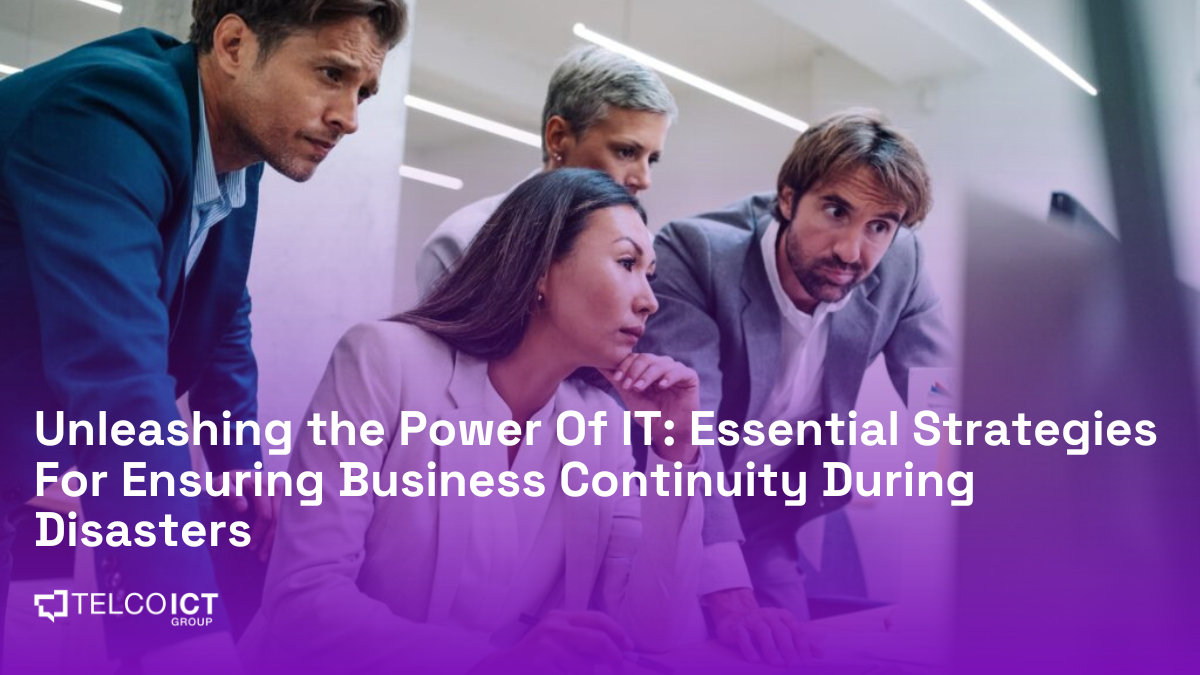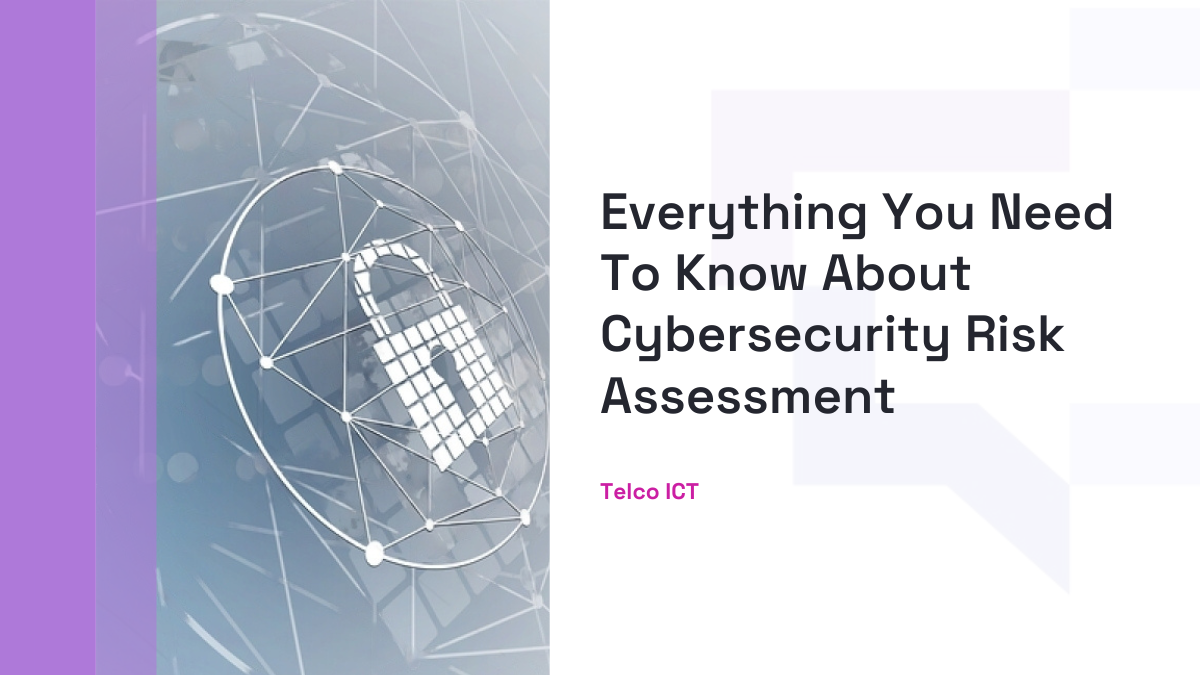All Posts / Unleashing the Power Of IT: Essential Strategies For Ensuring Business Continuity During Disasters
Cyber security
Unleashing the Power Of IT: Essential Strategies For Ensuring Business Continuity During Disasters

Prevention is obviously better than cure!
This phrase has never made more sense than now. This is because Business Continuity makes more sense when it comes to disaster recovery since they are closely related. So how did we get here?
Organisations began creating disaster recovery plans in the 1970s, with a primary focus on natural disasters. The emphasis switched to a more comprehensive viewpoint known as Business Continuity starting in the 1980s.
Every business out here needs to have a backup plan for anything and everything. Be it in your IT strategies, business strategies, or even your growth strategies, you need to prepare for the rainy days.
Business continuity intended to create a proactive approach that would keep firms alive and working even in the face of a big crisis, whereas disaster recovery narrowly focused on how to get systems back up after a disaster. As a result, a disaster recovery plan is restricted to protecting data, avoiding system damage, and fast restoring systems, whereas a business continuity plan encompasses all facets of the company, including business operations, human resources, partners, and suppliers.
And now you’re probably asking yourself; Should we still have a business continuity plan for disaster recovery even if a disaster never occurs? The simple answer is YES! Why?
Here’s why:
Any event that renders a business powerless, whether because of the weather or another form of catastrophe, will disrupt regular operations and have an effect on the bottom line. Business interruption risk might be physical, virtual, reputational, or financial. Therefore, regardless of the risk, planning is paramount.
It takes more than merely developing a business continuity plan and putting it on a shelf to make it truly effective in the event of a crisis. Business continuity management can help in this situation.
For instance, weather-related interruptions can result in structural damage to buildings, equipment damage, power outages, infrastructure damage, staff injuries, and excessive wind or water damage.
If we were to plan for the recovery in such a case, then there should be a formal BCP. In addition to a formal BCP, there should be a windstorm/flood emergency plan to reduce the exposures. To implement the plan, the response team would be given roles and responsibilities, emergency supplies would be gathered in a secure location, salvage and recovery operations would be planned, a list of important vendors, contractors, and suppliers would be kept, and equipment, stock, records, and other valuable operational pieces would be moved to secure locations while doors and other vulnerable building openings would be sandbagged.
The bottom line: For the above case, a BCP is really necessary, but in the case that a disaster never happens, here are some reasons why BCP is important even in the absence of a disaster:
1. Risk Mitigation: A good Business Continuity Plan helps identify potential risks and vulnerabilities in your organisation’s operations. By proactively addressing these risks, you can reduce the likelihood of disruptions occurring in the first place. This risk mitigation can include addressing supply chain vulnerabilities, cybersecurity threats, and other potential issues.
2. Operational Efficiency: Efficiency is one of the most sought-after aspects of a business and organisations strive to achieve the highest level of efficiency at any cost. BCP involves a thorough assessment of your organisation’s processes and workflows. By doing so, you can identify inefficiencies and areas for improvement. Implementing these improvements can lead to increased operational efficiency and cost savings, even in normal business conditions.
3. Customer Confidence: Every customer needs to like they can trust you. Customers and stakeholders will feel more confident if you show your commitment to BCP. Even when things are going well, they are more likely to trust and keep doing business with a company that has a plan in place to assure continuity. Increased client loyalty and retention may result from this trust.
4. Legal and Regulatory Compliance: Business continuity planning is subject to legal and regulatory restrictions in various businesses. Legal and financial repercussions could result from failing to have a BCP in place. Keeping compliance is crucial, even in the absence of a calamity.
5. Competitive Advantage: Businesses that have strong BCPs are frequently better positioned in the market. In comparison to rivals that lack such preparedness, they may reassure prospective customers, partners, and investors that they are ready for unforeseen circumstances, making them a more alluring alternative.
6. Employee Morale: Employee morale and anxiety can be improved by knowing that their employer has a plan in place to safeguard their security of employment and well-being. Higher productivity and decreased turnover rates may follow as a result.
7. Adaptability: a BCP promotes flexibility and adaptability in organisations. This kind of thinking can be used in a variety of areas of the company, assisting in its growth and ability to compete in a market that is continuously changing.
8. Continuous Improvement: BCP is a continuing process that changes with the organisation rather than being a one-time event. In order to keep the organisation effective and resilient, regular reviews and revisions to the plan can assist in uncovering new risks and possibilities for improvement.
9. Supply Chain Resilience: A key component of BCP is evaluating and improving the supply chain’s resilience. Even in the absence of a calamity, having a resilient supply chain can help your business react more quickly to changes in the market and supply chain disruptions.
Business Continuity Plan: What is it and What does it Entail?
Business continuity dictates how a company will carry on with its operations and provide for its clients in the case of a dramatic occurrence, such as a natural disaster, significant IT failure, or cyberattack. The ultimate objective is to maintain a company’s financial stability, market position, reputation, and clients notwithstanding a crisis.
Business continuity is essential at a time when downtime is unacceptable. There are numerous causes of downtime. Threats like cyberattacks and severe weather seem to be escalating. Cyberattacks are becoming more sophisticated and exploiting shoddy cybersecurity threat detection, according to Gartner. As a result, it’s crucial to have a business continuity plan in place that takes into account any potential business interruptions.
During a crisis, the organisation should be able to function at least minimally thanks to the plan. The organisation can remain resilient and react promptly to an interruption thanks to business continuity. Business reputation, time, and money are all saved by strong business continuity. An extended outage increases the danger of losing money, reputation, and other assets.
Every area of the business is covered by business continuity planning, including:
- Operations: How can a business process continue to function if essential tools or supplies are missing?
- Human resources: If, for instance, workstations are destroyed or there is no Internet access, how can essential staff members continue to complete their tasks?
- Stakeholders: How can business partners and suppliers continue working with the company if, for instance, communication channels or road transportation are down?
What is a Business Continuity Plan?
A mechanism for protecting against and recovering from potential risks to a business is called a business continuity plan (BCP). In the event of a disaster, the plan makes sure that people and property are safeguarded and can operate rapidly.
BCP is a crucial component of the organisation’s risk management strategy since it entails defining all hazards that may have an impact on the business’s operations. Natural disasters—fire, flood, or weather-related events—as well as cyberattacks may constitute risks. Once the risks are known, the strategy should additionally contain the following:
- Examining the procedure to make sure it is current
- Putting measures and processes in place to reduce hazards
- Estimating the impact of certain risks on operations
- Processes are tested to make sure they work.
It is important to note that threats and interruptions result in lost sales and increased expenses, which lower profitability. Additionally, since insurance doesn’t cover all expenses or clients who switch to the competition, businesses cannot rely only on it. Typically, it is planned out in advance with input from important parties and staff.
Why have a business continuity plan?
Businesses are vulnerable to a wide range of catastrophes, from minor to catastrophic. Business continuity planning is often intended to assist an organisation in carrying on operations in the case of significant calamities like fires. BCPs are distinct from disaster recovery plans, which are concerned with restoring an organisation’s IT infrastructure following a crisis.
Think about a finance firm with headquarters in a big city. It might implement a BCP by taking actions like offshore backups of its computer and customer files. Satellite offices of the company would still have access to crucial information if something were to happen to the corporate office.
It’s crucial to keep in mind that BCP could not be as successful if a significant section of the population is impacted, as might happen in the event of a disease outbreak. However, BCPs can enhance risk management by halting the propagation of disturbances. Additionally, they can reduce network or technological downtime, saving the business money.
How to Create a Business Continuity Plan: A Guide
To create a strong BCP, many businesses must take a number of stages. They consist of:
- Business Impact Analysis: The company will identify time-sensitive functions and resources in this analysis.
- Recovery: In this section, the company must decide what recovery measures to take and put them into action.
- Organisation: It is necessary to form a continuity team. This group will create a strategy to control the disturbance.
- Training: The continuity crew needs to go through testing and training. Team members should also finish drills that review the plan and strategies.
One thing for sure is that your business can find value in a checklist that contains vital details like emergency contact info, a list of probable resources the continuity team would need, the location of backup data, and other necessary information as well as other important people.
You should then test the BCP itself as well as the continuity team. It should be put through many tests to make sure it can be used in a variety of risk circumstances. This will make it easier to spot any vulnerabilities in the strategy, which can then be fixed.
What Should Be Included in a Business Continuity Plan (BCP)?
As we have established above, business continuity is a comprehensive and proactive strategy used by organisations to make sure they can carry on with their core tasks and provide vital goods and services even in the face of setbacks, catastrophes, or unforeseen events. In order to preserve or swiftly resume regular business operations, reduce downtime, and minimise possible losses in the case of a crisis, it involves planning, tactics, and procedures. This is what it involves:
1. Risk Assessment and Analysis: The first step in business continuity planning is to identify and assess potential risks and threats that could disrupt operations. This includes natural disasters (like earthquakes or floods), man-made disasters (such as cyberattacks or supply chain disruptions), and internal issues (like equipment failures or employee strikes).
2. Business Impact Analysis (BIA): Organisations analyse the potential impact of these risks on their operations. BIA helps prioritise critical functions, processes, and resources that need to be protected or restored quickly to minimise the overall impact of a disruption.
3. Developing a Business Continuity Plan (BCP): Based on the risk assessment and BIA, organisations create a comprehensive BCP. This plan outlines specific strategies, actions, and responsibilities to be taken before, during, and after a disruptive event. It includes:
- Emergency Response Procedures: Immediate actions to ensure employee safety and limit damage during a crisis.
- Crisis Communication Plans: Protocols for keeping stakeholders informed, including employees, customers, suppliers, and the public.
- Alternate Facilities and Resources: Identifying backup locations, equipment, and resources to maintain essential functions.
- Data Backup and Recovery: Strategies for backing up and restoring critical data and IT systems.
- Supplier and Vendor Management: Contingency plans for working with suppliers and vendors to ensure the supply chain remains intact.
- Employee Training: Ensuring that employees are trained to respond effectively during a crisis.
- Testing and Exercises: Regularly testing and simulating various disaster scenarios to assess the effectiveness of the plan.
4. Implementation and Execution: During a crisis, the BCP is put into action. This involves activating emergency response teams, relocating staff, restoring IT systems, and executing other predefined procedures to maintain essential functions.
5. Continuous Monitoring and Review: Business continuity is an ongoing process. Organisations must continually monitor and review their plans to ensure they remain up-to-date and effective. This includes revising the plan as the business evolves, adapting to new risks, and incorporating lessons learned from past incidents.
6. Crisis Communication: Effective communication is crucial during a crisis. Clear and timely communication helps manage public perception, maintain stakeholder trust, and coordinate actions. It’s essential to have communication plans in place for both internal and external audiences.
7. Compliance and Legal Considerations: Organisations must consider legal and regulatory requirements related to business continuity planning. Compliance with industry-specific standards and government regulations may be necessary.
8. Insurance and Financial Planning: Evaluating insurance coverage and financial strategies to mitigate potential financial losses resulting from a disruption.
9. Employee Well-being: Ensuring that employees are safe and informed during a crisis is a top priority. BCPs often include provisions for employee support and assistance.
10. Documentation and Reporting: Maintaining thorough documentation of the planning process, actions taken during a crisis, and outcomes is essential for future improvements and compliance reporting.
A Business Continuity Plan Has Seven Chapters
Sections of a typical business continuity strategy include:
1. Goal/Objective: The plan’s objectives should specify which areas of the company are deemed crucial and how well they should function in a crisis.
2. Personnel: Those in charge of running a crisis plan and keeping the business continuity program up to date. Which other stakeholders—senior management, legal counsel, public relations, clients, partners, etc.—exist, and how they should be told or involved?
3. Company Impact Analysis: This is a comprehensive examination of crucial company procedures, highlighting any weaknesses and predicting how various sorts of disasters may affect them.
4. Budget: resources allotted for planning and preparing for business continuity
5. Preventative measures: These are procedures that should be followed regularly to better withstand or avert calamities.
6. Immediate reactionary strategies: what the organisation should do to keep running as soon as a calamity strikes. This will often involve short-term solutions, such as supplying electricity when the power is off using a portable generator.
7. Long-term reactive strategies: These are actions that should be taken by the organisation on “day two” following the end of the disaster to fully recover and restore systems to their previous state.
Business Continuity vs Disaster Recovery
The two concepts are mostly used wrongly and interchangeably. So do they actually mean the same thing? Is it right to use them in place of one another?
Many professionals, who find comfort in rhythms and routines, operate under the idea that their workplace will essentially remain unchanged from one day to the next. Events do, however, occasionally interfere with daily operations. Making plans and strategies that can maintain core business operations even under pressure is a crucial part of leadership preparation for these interruptions.
Company continuity and catastrophe recovery are two distinct domains that deal with probable company interruptions. These practices reduce the potential negative effects that a catastrophic catastrophe might have on a company’s capacity to consistently offer its goods and services.
Even if both professions are significant and even resemble one another in some ways, they are not the same thing. Those in leadership or emergency preparedness roles can benefit from understanding the key differences between business continuity and disaster recovery.
What is Disaster Recovery?
The strategies that a business creates to handle significant occurrences like fires, floods, terrorist attacks, active shooter scenarios, and cybercrimes are referred to as disaster recovery. Disaster recovery describes the actions an organisation takes in the wake of an incident to quickly return to safe, normal operation.
Similarities Between Disaster Recovery and Business Continuity
Planning for business continuity and catastrophe recovery frequently appear to be related processes. Although the two ideas are not the same, they do share some similarities and function best when developed together. These are:
- Both are proactive steps that help a business get ready for unforeseen, disastrous occurrences. Instead of reacting to a disaster, both professions employ a preventive approach to limit its impacts before they occur.
- Businesses can use both to prepare for a range of calamities, both natural and man-made. Business continuity and disaster recovery are crucial in the event of pandemics, natural catastrophes, wildfires, and even cyberattacks.
- Both require routine evaluation and, sometimes, change to make sure they align with the company’s changing aims. These strategies will be regularly tested and adjusted as necessary by an emergency management leader.
Differences Between Disaster Recovery and Business Continuity
A thorough comparison of business continuity and catastrophe recovery reveals several key distinctions. These variations ultimately underscore the need for organisations to have both types of strategies in place in order to be adequately prepared for disaster. They include:
- Disaster recovery focuses on recovering data access and IT infrastructure after a disaster, whereas business continuity focuses on keeping operations running throughout a disaster. In other words, the former aims to keep the shop open despite exceptional or bad circumstances, whilst the latter concentrates on quickly getting things back to normal.
- Disaster recovery techniques, in contrast to business continuity plans, could entail adding extra employee safety precautions, such as holding fire drills or getting emergency supplies. By combining the two, a company may give equal attention to sustaining operations and guaranteeing employee safety.
- Disaster recovery and business continuity have different objectives. Successful disaster recovery plans restrict irregular or inefficient system function, whereas successful business continuity plans limit operational downtime. Businesses can only completely prepare for bad circumstances by integrating the two plans.
- In the middle of a crisis, a business continuity plan helps guarantee that communication tools like phones and network servers continue to function. A disaster recovery plan, meanwhile, aids in ensuring that a company can resume normal operations following a tragedy. To put it another way, disaster recovery focuses on bringing things back to normal whereas business continuity focuses on keeping the lights on and the firm operating in some fashion.
- Some companies may include catastrophe recovery plans in their comprehensive business continuity plans. One phase in the larger process of protecting a business from all contingencies is disaster recovery.
20 Important Strategies for Maintaining Business Continuity amid Disasters.
Ensuring business continuity during disasters requires a multifaceted approach that encompasses various essential strategies and considerations. Here’s a discussion of each of these key components:
1. Emergency Planning: Think of it as the stage manager’s script for a high-stakes play. You’ve got evacuation routes clearly marked out, like the glowing exit signs in a dark theatre. In your backstage emergency kits, there are first aid supplies, snacks, and walkie-talkies – props for any plot twist. And don’t forget the rehearsals: regularly scheduled evacuation drills to ensure everyone knows their lines when the curtain rises on an emergency.
In the event of an emergency, you’ve meticulously prepared a detailed plan. It includes clearly marked evacuation routes, emergency kits stocked with essentials, and regular drills to ensure everyone knows their roles when faced with unexpected situations.
2. Data Protection: Imagine your data as precious gems hidden away in a secure vault. You’ve got backup crews working tirelessly to create copies of these gems, and they’re encrypted like ancient scrolls, protected from prying eyes. Only those with secret passcodes can even get close to them.
Your data is safeguarded like valuable treasures locked away in a secure vault. Backup procedures are in place to create copies, and encryption keeps unauthorised access at bay, allowing only those with proper access codes to approach it.
3. Risk Management: Picture yourself as a seasoned detective, constantly surveying your surroundings for potential threats. You’ve got a magnifying glass to scrutinise every nook and cranny for clues about what could go wrong. When you find a shady character, you devise clever strategies to outsmart them before they can make a move.
You approach risk as a vigilant detective, continuously scanning for potential threats. You thoroughly investigate every aspect, seeking out potential issues and devising strategies to mitigate them before they can escalate.
4. IT Systems: Think of your IT systems as the engines that keep the business ship afloat. To make sure they never stall in the middle of a storm, you’ve got spare engines, lifeboats, and a skilled crew who can fix anything from a minor hiccup to a major engine failure. And just like a well-maintained ship, your systems are always shipshape, thanks to regular updates and patches.
Your IT systems are the engines driving your business, and you’ve ensured their reliability with spare components, skilled technicians, and routine maintenance, ensuring they run smoothly even in challenging conditions.
5. Crisis Management: In the face of a crisis, you are the leader with a team of experts who are well-prepared and trained to handle unexpected situations. Your extensive preparation allows you to guide your team calmly and effectively to resolve issues and restore order.
6. IT Resilience: Your IT infrastructure is akin to a fortress, equipped with backup systems ready to take over if the primary ones fail. Your disaster recovery plans ensure swift recovery in the face of adversity.
7. Disaster Response: In times of crisis, you have a network of contacts, plans, and records ready to navigate through challenging situations, similar to a captain steering a ship through a storm.
8. Technology Continuity: Think of your technology solutions as secret weapons in a spy’s arsenal. If one gadget fails, you’ve got backups that can seamlessly step in, ensuring that the mission goes off without a hitch. And when it’s time to deploy, the cloud is your spy plane, ready to provide air support whenever and wherever you need it.
Your technology solutions act as fail-safes, stepping in seamlessly if primary systems encounter issues, much like a spy’s backup gadgets ensuring the mission’s success.
9. Backup and Recovery: Imagine your critical data as a priceless art collection. You have a team of conservators carefully restoring and copying each masterpiece. They practise their restoration skills regularly to ensure that when a painting is damaged, they can restore it to its former glory.
10. Cloud Solutions: Think of the cloud as your genie’s lamp. With a rub and a wish, you can instantly summon scalable computing power and data storage from thin air. It’s like having a magical assistant who can conjure whatever you need, whenever you need it.
11. Remote Work Solutions: Imagine your workforce as a troop of explorers. Equipped with secure remote access tools and guided by thorough training, they can venture out into the wild world of remote work, overcoming any obstacle that might come their way.
12. Redundancy Planning: Visualise your critical systems as acrobats performing daring stunts. With safety nets below and backup performers waiting in the wings, you’re prepared for any unexpected falls. And just like a well-choreographed routine, your redundancy plans ensure a seamless show even if someone misses a step.
13. Data Backup: Picture your data backups as a time machine. They capture the essence of your business at different points in time, preserving it for future generations. And like a diligent historian, you ensure these time capsules are stored safely off-site, ready to be opened in case of emergency.
14. Critical Systems: Imagine your critical systems as the VIPs at a gala event. They get the red carpet treatment, with designated bodyguards and an exclusive after-party. You’ve even arranged for understudies in case any of them decide to take an unplanned break.
VIP treatment is given to crucial systems, with backups and contingency plans to minimise downtime.
15. Cybersecurity Measures: Think of your cybersecurity measures as an impenetrable fortress, surrounded by vigilant guards. They patrol the perimeter, watchful for any suspicious activity, and they’re well-trained to ward off cyber invaders. And like a master of martial arts, your team is always ready to deflect cyberattacks.
Vigilant guards protect your digital fortress, with a well-trained team ready to fend off cyber threats.
16. Communication Protocols: Imagine you’re a maestro conducting a symphony. Your orchestra is made up of communication channels – each one playing a vital role. When you wave your baton, they all harmonise to keep everyone informed and in sync.
Like a conductor leading an orchestra, your work is to coordinate various communication channels to keep everyone informed and aligned.
17. Incident Response: Your incident response team operates like detectives, methodically gathering information to solve problems and prevent recurrences.
18. Recovery Time Objective (RTO): Imagine you’re a chef in a high-end restaurant. Each dish you prepare has a precise cooking time, and you’re committed to serving it at its peak. Similarly, your RTOs are like cooking times for your systems – they determine when each dish (or system) should be ready to serve. Visualise your RPO as a safety net for a high-flying trapeze artist. It’s the maximum distance they’re willing to fall without harm. Your RPO sets the limit for how much data you’re willing to lose if something goes wrong.
RTOs function like prec
19. Virtualization: Virtualization provides flexibility, much like a magician’s hat that produces an endless array of tricks.
20. Business Impact Analysis: You should always analyse your business from time to time. Imagine your business as a complex ecosystem, with various species of processes and functions. The Business Impact Analysis is like a biologist’s fieldwork, carefully studying each species to understand its role and importance. This knowledge guides your conservation efforts, ensuring that your ecosystem can weather any storm.
These strategies, when thought of in vivid and relatable terms, bring business continuity to life and make it easier to understand and implement in the real world.
Conclusion
In the world of business, the unexpected is a lurking understudy, always ready to take centre stage. That’s where Disaster Preparedness comes into play, like a well-rehearsed safety net, ensuring your business is ready for whatever plot twists may come its way.
When it comes to Business Resilience, think of it as the script supervisor, making sure that no matter what challenges arise, your business can adapt, improvise, and carry on with the show.
But there’s another unsung hero in this narrative: Telco ICT. It’s the backstage crew that keeps the lights on and the show running smoothly. Whether it’s through cloud solutions, remote work options, or robust communication networks, Telco ICT can help your business craft a solid Business Continuity Plan (BCP), ensuring that even in the face of unexpected disruptions, the show can go on without a hitch.
So, as the curtains close on this discussion, remember that with Disaster Preparedness, Business Resilience, and the practical support of Telco ICT, your business is poised for an encore, ready to shine in the face of adversity. After all, in business, the show must—and will—go on!
Table of contents
Related Posts
We’ll handle the tech
so you can get on with
running your business.

CALL US
1300 414 214
Our Trusted Partners
Contact Us
Let’s Talk
Common Questions
Do you outsource your work overseas?
No. We use local teams only. That way we can respond more quickly to any problems that may occur. We want your tech running smoothly so you can focus on what you do best.
Is your support 24 hours?
Yes. We have people available whenever you need us. We understand that your tech runs 24 hours, and you need it be working at all times.
Are your services customised for my business?
Yes. There is great off the shelf software. But we know one size never fits all. So anything we set up for you is designed to make your business run smoother and in the way you want it to.
Are your services expensive?
No. Reliable tech is the life blood of your business. We keep it running smoothly so your business can keep making money. All our services are fixed fees, so you never get any nasty surprises.
What’s the next step?
Simply book a chat with one of our experts. We’ll have a chat about exactly what you need and how we can help. If you like our approach then we’ll give you a fixed price quote and get everything up and running for you, fast!








